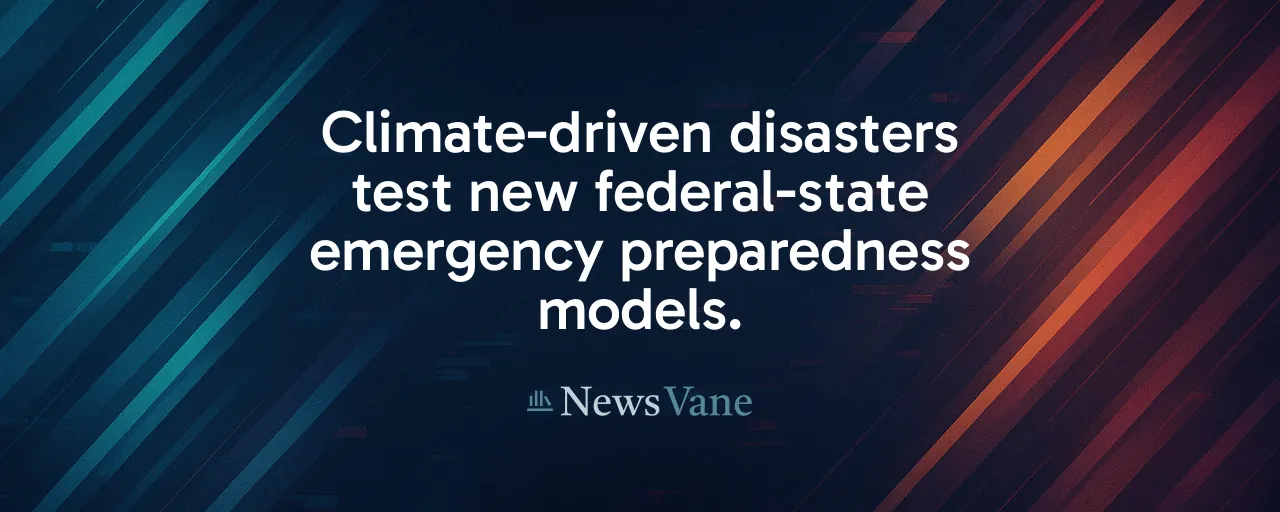A Flood of Change Hits Disaster Response
When flash floods tore through Texas’s Guadalupe River in July 2025, the devastation left communities reeling. Homes vanished, roads crumbled, and lives were lost. As rescue teams scrambled, a national conversation erupted, fueled by recent news coverage. Journalist Aaron Rupar pointed to President Trump’s boasts about slashing federal disaster aid, noting how quickly the public tied the tragedy to his policies. The floods became a flashpoint, exposing a deeper question: how should America prepare for and respond to catastrophes?
Trump’s agenda, rolled out since early 2025, seeks to shrink the federal footprint in emergencies. Plans to phase out the Federal Emergency Management Agency (FEMA) after this hurricane season, alongside cuts to the National Weather Service and hazard-mitigation grants, have stirred fierce debate. Some praise the shift toward state-led solutions, while others warn it risks lives and widens inequality. The Texas disaster brought these tensions into sharp focus, demanding a closer look at what’s at stake.
Disasters don’t wait for policy debates to settle. With climate-driven events rising, the nation faces a critical moment. Can a leaner federal role deliver effective relief, or will it leave communities vulnerable? This article dives into the evidence, weighing how federal and state systems can work together to protect lives and rebuild stronger.
The Federal Role Under Scrutiny
FEMA, created in 1979, has long anchored America’s disaster response. Its $31 billion budget in 2024, though just 0.5 percent of federal spending, supports everything from flood relief to earthquake preparedness. Research underscores its value: hazard-mitigation grants have averted $180 billion in losses since 1989. Studies also show that coordinated federal-state efforts cut recovery times and costs, with mitigation yielding $6 saved for every $1 spent. These numbers highlight why FEMA’s potential phase-out raises alarms.
Trump’s push, formalized through Executive Order 14180, calls for a top-to-bottom review of preparedness policies. His administration argues that FEMA’s size breeds inefficiency, citing slow reimbursements and mismanagement after past storms like Katrina. Supporters of this view point to Texas’s rapid flood response in July 2025, declared a state emergency within 24 hours, as proof that local governments can act swiftly without federal red tape.
Yet, the data tells a broader story. Peer-reviewed studies find that multi-state disasters, like cross-border hurricanes, demand federal logistics that states alone can’t replicate. Cuts to forecasting, such as National Weather Service staffing reductions, also risk weaker warnings, which historically lower relief costs by enabling evacuations. The challenge lies in balancing streamlined processes with robust capacity.
States Step Up, But Gaps Remain
As federal support wanes, states face growing pressure to fill the void. Governors and local officials, already stretched by tight budgets, must now plan for worst-case scenarios. Texas’s flood response showed state agility, but not all regions have equal resources. Wealthier states can invest in resilient infrastructure, while poorer ones struggle to fund basic recovery, potentially deepening inequality.
Historical examples reveal the stakes. After Hurricane Andrew in 1992, federal aid stabilized Florida’s economy, preserving jobs and tax revenue. Conversely, Puerto Rico’s slow recovery post-2017 hurricanes, hampered by delayed aid, fueled long-term economic strain. Research from the Congressional Budget Office suggests that federal backstops prevent bond-rating downgrades in hard-hit areas, a risk now looming for cash-strapped states.
Interstate mutual-aid pacts offer one solution, but they rely on coordination FEMA currently provides. Without federal supply chains for essentials like shelter or fuel, bottlenecks could stall relief. The evidence points to a clear need: states can lead, but a federal safety net ensures no community is left behind.
Finding Common Ground
Amid the debate, practical solutions emerge. Experts propose hybrid models where states handle routine disasters, but a federal reserve fund covers massive crises like earthquakes. Tying aid to state investments in modern building codes could incentivize prevention while easing federal burdens. Digital platforms to streamline FEMA’s paperwork, a frequent complaint, also hold promise for faster reimbursements.
Another idea gaining traction is a bipartisan commission to set clear disaster declaration criteria, reducing perceptions of political bias. Past controversies, like aid denials to certain states, underscore the need for transparency. On forecasting, maintaining baseline staffing at the National Weather Service while partnering with private firms could preserve warnings without bloating budgets. These steps aim to blend local innovation with federal reliability.
The economic and social stakes add urgency. Disasters boost local employment through recovery, but stalled efforts increase mental-health strain and inequality. Legal questions also loom: the Stafford Act gives presidents wide discretion, but Congress could reshape FEMA’s role, navigating federalism debates. Compromise offers a path to resilience.
Building a Resilient Future
The Texas floods of 2025 exposed a nation at a crossroads. Trump’s push to rethink disaster policy challenges decades of federal leadership, but it also opens a chance to refine how America prepares and recovers. The evidence is clear: coordinated systems save lives, time, and money. States can lead with agility, but federal support remains vital for equity and scale.
Communities, from rural towns to urban centers, deserve systems that prioritize prevention and swift recovery. Solutions like hybrid funding, transparent criteria, and smarter forecasting can bridge divides, ensuring no one faces a crisis alone. Policymakers, local leaders, and taxpayers must weigh these options carefully, grounded in data and shared goals.
As storms grow fiercer and debates rage on, one truth stands out: resilience demands cooperation. By blending the best of local and federal strengths, America can weather any challenge, rebuilding not just homes but trust in a system that works for all.
